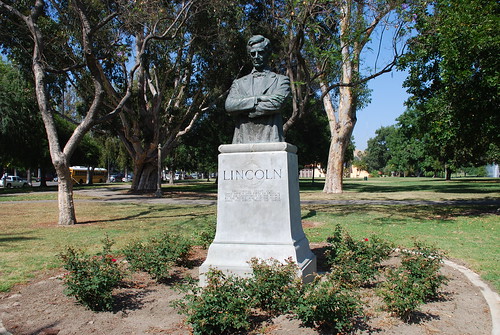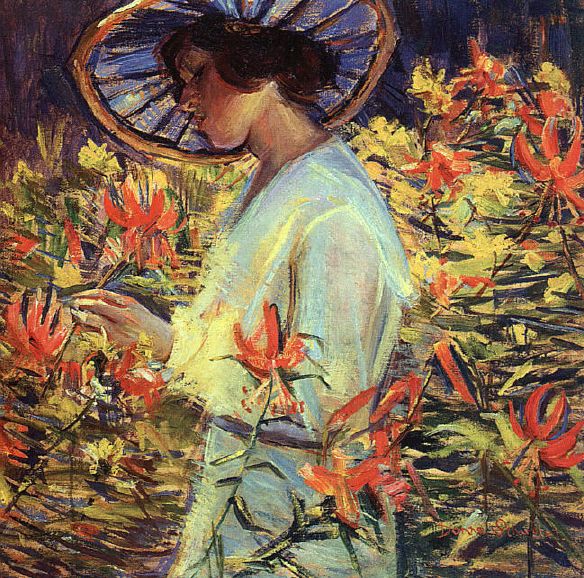| 1871-1942
|
By the time she was sixteen years old, she found work as a domestic servant for a woman who recognized her talent and drive, and paid to enroll her in the Chicago Art Institute. She studied with Lorado Taft for six years and by 1887, she became his studio and teaching assistant. Wendt earned an excellent reputation over the course of her career and was referred to as the "foremost woman sculptor of the west...whether men or women."
 |
| Julia Bracken Wendt Music ca. 1915 Bronze 8 7/8 x 7 1/4 inches |
Wendt, who sculpted portraits, fountains, and bas-relief medallions in bronze, was not a modernist in artistic style, but she proclaimed her feminist sensibilities in her contribution to the Panama Pacific International Exposition held in San Francisco in 1915, and in San Diego in 1916. Wendt proved to be an exceptional artist and was the only woman to win a gold medal for her work.
It was Wendt who originated the idea of placing the sculptured figures that typified the attributes of woman in the Women's building of the exposition, and it was she who carried the project through to the finish. Wendt not only created the figures, she completed the work on her own. She supervised the installation and raised the statues to their pedestals when the workmen were confounded with the process. Wendt demonstrated her executive ability, creativity, and problem-solving skills with thoughtfulness and imagination. Sculpture is a demanding, physical, endeavor that requires much more strength than that of painting on paper or canvas.
After successfully pursuing her career for a number of years, Wendt married painter William Wendt and moved to Los Angeles, California, in 1906, where they became a highly prominent artist couple. Wendt taught at the Otis Art Institute and became a member of the National Sculpture Society.
Julia Bracken Wendt
National Women's Trade Union Seal
Pen and ink drawing on board
Manuscript Division
Gift of the National Women's Trade Union League
Gift of the National Women's Trade Union League

Julia Bracken Wendt
Three Muses (Science, History, and Art)
ca. 1911
Natural History Museum Rotunda
In 1913, she was commissioned by the government of Canada to create a King Edward Peace Memorial, which was installed at Saskatoon.
ca. 1915
Photographer unknown
Handwritten caption: CHRISTMAS GREETING FROM JULIA BRACKEN WENDT TO CHAS. F. LUMMIS
Julia and William in their Laguna Beach Studio
 |
| Julia Bracken Wendt Lincoln the Lawyer ca. 1926 Lincoln Park, Los Angeles, CA |
Exhibitions:
World's Columbian Exposition, Chicago, 1893
Annual Exhibition, Palette Club, AIC, 1895
Annual Exhibition of Works by Chicago Artists, AIC, 1899-1910 (9 times)
St Louis/Louisiana Purchase Exposition, 1904
Chicago Municipal League, 1905
Pan-California Expo, San Diego (CA), 1915
California Art Club, 1918
Solo exhibits with husband, AIC, 1909-21
National Sculpture Society, 1929
National Sculpture Society, Los Angeles (CA) Museum
Awards:
Commission, "Illinois Welcoming the Nations" for Columbian Exposition, Chicago, 1892
Commission, Exposition Park, Los Angeles (CA). Commission, Battle Monument, Missionary Ridge (TN)
Sculpture Prize, Chicago, 1898
Municipal Art League Prize, Chicago, 1905
Gold Medal, Pan-California Expo, San Diego (CA), 1915
Harrison Prize, Los Angeles (CA), 1918
Memberships:
Chicago Society of Artists
Chicago Municipal Art League
Society of Western Artists
Los Angeles (CA) Fine Art Association
California Art Club, Los Angeles
NAC
Three Arts Club of Los Angeles (CA)
Laguna Beach Art Association
Collections:
Los Angeles (CA) County Museum of Art
____________________________________________________________
Sources:
Waggoner, "The art of J.B. Wendt," Los Angeles Herald Sunday Magazine, March 27, 1910, p.1.
Edenhurst Gallery, Julia Bracken Wendt, http://www.edenhurstgallery.com/painting.php?id=1929, retrieved 2/21/14
Illinois Women Artist Project, Julia Bracken Wendt, http://iwa.bradley.edu/artists/JuliaWendt, retrieved 2/21/14
AskART, http://www.askart.com/askart/w/julia_m_bracken_wendt/julia_m_bracken_wendt.aspx, retrieved 2/21/14
American Treasures of the Library of Congress, http://www.loc.gov/exhibits/treasures/trm167.html, retrieved 2/21/14
Yesterday and Tomorrow: California Women Artists, Sylvia Moore, ed. Midmarch Arts Press, New York, 1989.








